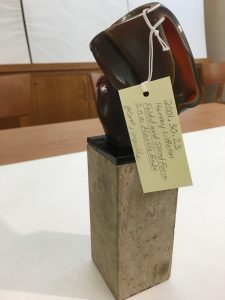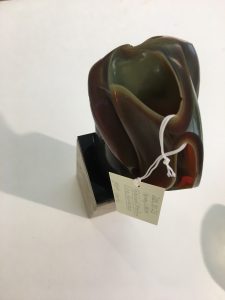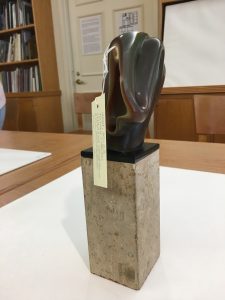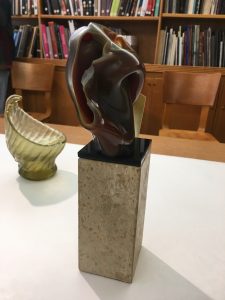 As someone drawn to midcentury contemporary art, it came as no surprise that I found myself immediately drawn to Harvey K. Littleton’s Folded and Sliced Form on a Marble Base, executed in 1968. Hailed as one of the foremost pioneers of the American Studio Glass Movement, Littleton originally produced ceramic works and ultimately sought to make training in the ancient art of glass blowing more accessible, moving opportunities to learn the process away from the factory setting and into the studio and changing glassblowing from a collaborative to a lone effort. Thus, he developed both equipment and a method for melting glass at lower temperatures. This allowed him to introduce glassblowing to the studio art curriculums of university programs. Littleton’s own
As someone drawn to midcentury contemporary art, it came as no surprise that I found myself immediately drawn to Harvey K. Littleton’s Folded and Sliced Form on a Marble Base, executed in 1968. Hailed as one of the foremost pioneers of the American Studio Glass Movement, Littleton originally produced ceramic works and ultimately sought to make training in the ancient art of glass blowing more accessible, moving opportunities to learn the process away from the factory setting and into the studio and changing glassblowing from a collaborative to a lone effort. Thus, he developed both equipment and a method for melting glass at lower temperatures. This allowed him to introduce glassblowing to the studio art curriculums of university programs. Littleton’s own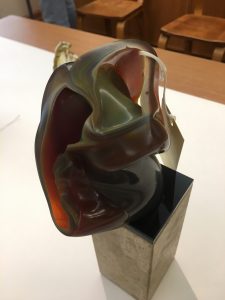 program, at the University of Wisconsin, allowed him to foster the talents of a generation of studio glassblowers, including Fritz Driesbach, the maker of Non-Bottle.
program, at the University of Wisconsin, allowed him to foster the talents of a generation of studio glassblowers, including Fritz Driesbach, the maker of Non-Bottle.
The glass form, which perches atop a short, rectangular column of cement-colored marble, gives the sense of a tube that has been folded in on itself many times, with creases and surprising openings where Littleton elected to cut the glass. The form is organic and supple, and seems to lead the viewer to perceive that, if they dared to touch it, it might be soft enough to squeeze and collapse. In color, the glass changes depending on where it is viewed from. At a distance, the work seems to be a deep brown color, but a closer look reveals an interplay of red, green, and yellow. The presence of these colors is most apparent where the work has been “sliced”; at each opening, each color is made known in a striation that runs the perimeter of the opening before fading into the next shade. It is also at these openings that the translucence we expect from glass is most apparent. When peering into the work, light shines through the glass’ thinnest parts and illuminates the interior with a reddish glow.
When I first saw the work, I was immediately reminded of diagrammatic representations of a human heart or sections of the intestines. Further examination revealed the interaction of the colors in the glass, like bile or other fluids in an organ, and the reddish glow made by light, as when the sun shines between your fingers, and the image was cemented. There’s something, as a living organism, that I find simultaneously empathetic and repulsive about these associations, something at once comforting, and equally disconcerting, about recognizing yourself and your own fragility in something on display. As a medium, particularly when used in work such as this, glass allows the artist and viewer to play with interesting material thresholds, as the frozen viscosity of the once heated substance evokes the tactile illusion of softness and, thereby, brings a sense of the visceral into something cold, delicate, and distant.
